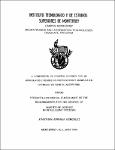| dc.contributor.author | Arriaga González, Jonathan | |
| dc.creator | Arriaga González, Jonathan; 268989 | |
| dc.date.accessioned | 2015-08-17T10:39:17Z | en |
| dc.date.available | 2015-08-17T10:39:17Z | en |
| dc.date.issued | 2010-05-01 | |
| dc.identifier.uri | http://hdl.handle.net/11285/570216 | en |
| dc.description.abstract | Robot manipulators play an important role in actual industrial processes. The trajectory following of robot manipulators is a non-linear problem that still requires much research [34]. This research work focuses on the control of the dynamics of an articulated robot manipulator. A 2 degree-of-freedom (DOF) articulated robot manipulator is simulated, each of the two links of the robot having its respective controller. Two different kind of control objectives for the robot's links are considered, position control and velocity control. Four control schemes for the robot's dynamics were selected. For position, a PID Controller [24] and a Fuzzy Self-tuning (FST) PID Controller [14] are considered. On the other hand, for velocity control the FST PD+ Controller [35] and the Fuzzy Sliding Mode (FSM) Controller [12, 16, 28] were chosen. Controller's performance and robustness in relevant tasks are evaluated and compared in order to determine which control scheme fits best for each task. Empirical adjustment of most controller's parameters always depend on the time and tests invested in tuning the controller, it is time consuming and subject to human error. As a fair comparison is intended, controller's parameters are optimized via Genetic Algorithms [22]. With this method, the tuning of parameters is not subtle to human error and the comparison can avoid possible erroneous conclusions. Optimization of parameters of all controllers was carried out successfully. Pa-rameters set by the GA are interpreted and show several details about the structure of the considered controllers. Performance comparison of controllers is discussed and conclusions about the complexity of controllers and its equivalence when performing some tasks is presented. | |
| dc.language | eng | |
| dc.publisher | Instituto Tecnológico y de Estudios Superiores de Monterrey | |
| dc.relation | Investigadores | es_MX |
| dc.relation | Estudiantes | es_MX |
| dc.relation.isFormatOf | versión publicada | es_MX |
| dc.relation.isreferencedby | REPOSITORIO NACIONAL CONACYT | |
| dc.rights | openAccess | |
| dc.rights.uri | http://creativecommons.org/licenses/by-nc-nd/4.0 | * |
| dc.subject.classification | Area::INGENIERÍA Y TECNOLOGÍA::CIENCIAS TECNOLÓGICAS::TECNOLOGÍA DE LOS ORDENADORES::LENGUAJES ALGORÍTMICOS | es_MX |
| dc.title | A comparison of control schemes for an articulated 2 degree-of-freedom robot manipulator optimized via genetic algorithms | |
| dc.type | Tesis de Maestría / master Thesis | |
| dc.contributor.department | Tecnológico de Monterrey, Campus Monterrey | en |
| dc.contributor.committeemember | Soto, Rogelio | es |
| dc.contributor.committeemember | Meza, José Luis | es |
| dc.contributor.committeemember | Rodríguez, Ernesto | es |
| refterms.dateFOA | 2018-03-24T18:31:53Z | |
| refterms.dateFOA | 2018-03-24T18:31:53Z | |
| html.description.abstract | Robot manipulators play an important role in actual industrial processes. The trajectory following of robot manipulators is a non-linear problem that still requires much research [34]. This research work focuses on the control of the dynamics of an articulated robot manipulator. A 2 degree-of-freedom (DOF) articulated robot manipulator is simulated, each of the two links of the robot having its respective controller. Two different kind of control objectives for the robot's links are considered, position control and velocity control. Four control schemes for the robot's dynamics were selected. For position, a PID Controller [24] and a Fuzzy Self-tuning (FST) PID Controller [14] are considered. On the other hand, for velocity control the FST PD+ Controller [35] and the Fuzzy Sliding Mode (FSM) Controller [12, 16, 28] were chosen. Controller's performance and robustness in relevant tasks are evaluated and compared in order to determine which control scheme fits best for each task. Empirical adjustment of most controller's parameters always depend on the time and tests invested in tuning the controller, it is time consuming and subject to human error. As a fair comparison is intended, controller's parameters are optimized via Genetic Algorithms [22]. With this method, the tuning of parameters is not subtle to human error and the comparison can avoid possible erroneous conclusions. Optimization of parameters of all controllers was carried out successfully. Pa-rameters set by the GA are interpreted and show several details about the structure of the considered controllers. Performance comparison of controllers is discussed and conclusions about the complexity of controllers and its equivalence when performing some tasks is presented. | |
| dc.identificator | 7 | |
| dc.identificator | 33 | |
| dc.identificator | 3304 | |
| dc.identificator | 120302 | |



